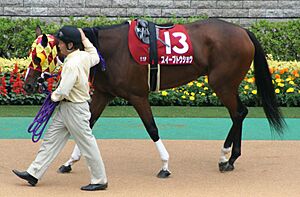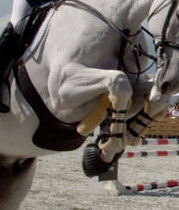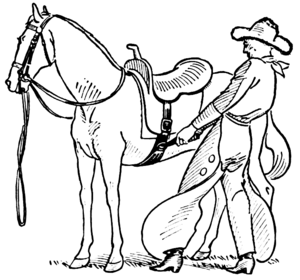Girth (tack) facts for kids
A girth is a special strap that helps keep a saddle in place on a horse. It goes under the horse's belly and connects to the saddle's straps, called billets. Girths are used with English and Australian saddles. Western saddles use something similar called a cinch. A cinch connects to a strap called a latigo on each side of the saddle.
Sometimes, just a girth is enough to hold a saddle. But in fast sports like polo, eventing, or show jumping, other gear is used. These include breastplates and overgirths. They add extra security for the saddle.
Studies show that girths might slightly limit a horse's ribcage movement. However, they do not stop the horse from breathing normally.
Types of Girths
Many girths are shaped to give the horse's elbows plenty of room. The Balding style is made of three leather strips. These strips cross and fold in the middle. The Atherstone style is a shaped leather piece. It has a stronger leather strip down its center. An overlay girth is similar, but its center piece is the same curved shape as the girth. This overlay often has cool stitched designs.
Some girths are not shaped. They are often made of thick cotton. Some are padded cotton with strong nylon. Leather tri-fold girths are also common. These are popular for sidesaddle riding and traditional foxhunting.
Horses with sensitive skin often use soft fleece girth covers. Some girths even come with sheepskin liners. These liners are attached or can be removed. They help protect the horse's belly.
A dressage girth is shorter than other girths. This is because dressage saddles have longer billet straps. These longer straps keep the buckles away from the rider's leg. So, a shorter girth can be used. Dressage girths come in many materials and styles. Some are even made entirely of strong elastic.
An overgirth or surcingle is often used with a regular girth. It is made of leather or nylon. It might have an elastic part for horse racing. The overgirth goes all the way around the horse's belly and over the saddle's seat. It gives extra security. Stockmen, eventers, polo players, and horse racing jockeys use them. They help keep the saddle firmly in place.
Some girths have a belly guard (or stud guard). These are used for jumpers and eventers. The guard protects the horse's belly. It stops the horse from hitting its belly with its horseshoe studs. This can happen when the horse tucks its legs up over a tall jump.
Fitting the Girth
A girth should spread pressure evenly. If it is too narrow, it might make the horse uncomfortable. It is best if the girth has some "give" or stretch. This makes it more comfortable for the horse. Many riders also pick a girth that allows extra room for the horse's elbows. This helps the horse move its legs freely.
To measure for a girth, first put the saddle and saddle pad on the horse. Then, use a measuring tape. Measure from the middle hole of the billet on one side. Go under the horse's belly to the middle billet on the other side.
If a girth is a little too small, you can use a girth extender. A girth extender attaches to the saddle's billets. It makes them longer, so a shorter girth can be used.
See also
 In Spanish: Cincha (equitación) para niños
In Spanish: Cincha (equitación) para niños
Images for kids





